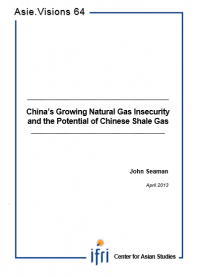China's Growing Natural Gas Insecurity and the Potential of Chinese Shale Gas Asie.Visions, No. 64, April 2013
China is poised for a dramatic increase in its demand for natural gas. As total energy demand has risen to record levels in the last five years, China has found itself in an increasingly difficult bind: the social and environmental burden from coal is becoming too heavy to bear and a growing dependence on foreign oil is becoming strategically more risky with the passage of time.

China’s policy-makers and strategists continue to favor indigenous resources whenever possible, but projected increases in demand are so great and the cost of nuclear and renewable energy sources still so high that natural gas has become an increasingly natural choice. The country’s gas demand is projected to double in the next three years, reaching 260 billion cubic meters per year (bcm/y) by 2015 as Beijing has set a target to increase the part of natural gas from 4% of China’s energy mix today to more than 8% by the end of the 12th Five Year Plan (2011-2015). Further projections show that Chinese gas demand could reach 400 bcm/y in 2020 and 550 bcm/y or more in 2030.
While this growing demand for gas will help China achieve its goals of reducing the carbon intensity of its GDP and cut much of the pollution from coal, it is also leading China further down a path it has long hoped to avoid: greater dependence on strategic energy imports. A pipeline project to pump gas from Turkmenistan through Central Asia began delivering supplies in 2009 and is expected to reach 40 bcm/y in the near future and possibly even 65 bcm/y or more by 2020. Another pipeline from Myanmar is expected to enter into service in 2013 and would be capable of delivering up to 12 bcm/y. Negotiations with Russia for pipelines that could deliver anywhere from 30-70 bcm/y are deadlocked over pricing, but the construction of LNG import terminals suggests that China could be capable of importing between 40-50 bcm/y of this sea-borne gas by 2015 and possibly even 100 bcm/y or more by 2020.
China’s increasing reliance on imports is creating a deepening sense of energy insecurity among many policymakers and strategists in Beijing. While there is an element of supply security in the diversification of sources, each of these options comes with its own risks: increasing vulnerability to various geopolitical interests, price volatility and instability in supply regions or along transit routes.
In this context, the success of the United States in revolutionizing its energy supply by producing large quantities of indigenous gas from shale plays has sparked the imagination of China’s energy planners. Recent estimates suggest that China has the largest recoverable reserves of shale gas in the world. Hoping to spur a shale gas revolution of its own, China’s authorities have set ambitious plans produce 6.5 bcm/y by 2015 and between 60-100 bcm/y by 2020.
But given the sheer size of China’s total energy demand and its projected growth, shale gas will not be a golden ticket to energy-independence, and it is unlikely that ambitious production goals will be met within the established time frame. Nevertheless, production from shale and other unconventional sources will play an important role in helping to diversify the country’s energy mix, influence energy prices and lessen the overall environmental burden from coal.
The degree of impact will depend on China’s ability to overcome a number of environmental, social, logistical and regulatory challenges. Many regions of the country such as the North and West will see their development stifled by water scarcity. Other basins in the South, where water availability is less of an issue, such as Sichuan, will still have to deal with the issues of population density, land access and pollution. These challenges are becoming more complicated given a context of increasing tension over land rights and over the effects of development projects on local human health and environmental sustainability. Moreover, logistical hurdles related to, among other things, a complex geology, inadequate infrastructure and insufficient human capital will also have to be overcome. An uncertain regulatory framework governing the shale gas sector must also be clarified - a task that will undoubtedly be influenced by the willingness for and directionality of a broader reform agenda on the part of China’s new leadership. Among the regulatory issues to be dealt with for a smoother development of the shale gas industry are: the role of private and foreign enterprises and their relationship with state-owned companies; questions over land management and pipeline access; and the matter of price liberalization. If China is going to adequately deal with these challenges, it will most likely need more time than Beijing’s current set of targets is hoping for.
In the absence of significant development of China’s shale gas resources in the next decade, import demand from China will be a major driver of both regional and global gas demand. As a consequence, China will have an increasing need to deepen its bilateral relationships with current and potential suppliers, particularly of LNG. This means greater competition with Asia’s other major gas consumers - Japan, South Korea and India - but also a growing importance for regional LNG suppliers such as Australia and others further abroad such as the GCC countries in the Persian Gulf. In the long term, China’s development of shale and other unconventional gases may temper its growing need for imports, but will by no means erase it.


